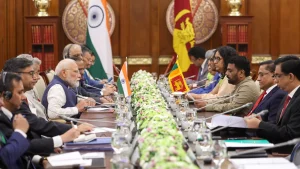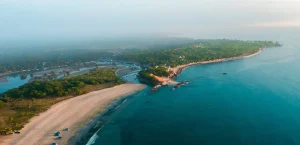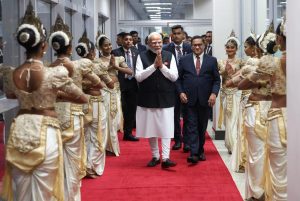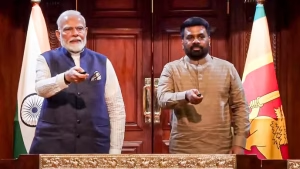New Delhi – Modi’s visit to Sri Lanka has resulted in a milestone moment for India-Sri Lanka bilateral relations. Marked by high-level discussions, the visit focused on enhancing defense collaboration and energy cooperation. This was not merely a symbolic trip, but a calculated diplomatic outreach aimed at reinforcing India’s strategic presence in the Indian Ocean and boosting South Asia’s energy security. As part of this visit, PM Narendra Modi engaged in a series of talks with top Sri Lankan leaders, which culminated in the signing of a five-year defense cooperation agreement and an ambitious plan for a joint solar power plant in Trincomalee.
The significance of Modi’s visit to Sri Lanka extends beyond bilateral diplomacy; it reinforces India’s commitment to regional partnerships and marks a bold step in countering growing external influences in the Indian Ocean Region (IOR). By focusing on defense and renewable energy—two areas crucial to regional stability and development—Modi’s administration has sent a strong message of strategic foresight and regional leadership.
Historic Defense Pact: Strengthening Regional Security

One of the most impactful outcomes of Modi’s visit to Sri Lanka is the signing of a five-year defense cooperation pact. This agreement outlines a framework for sustained defense engagements, joint military exercises, maritime cooperation, and capacity building.
India and Sri Lanka have a long history of defense collaboration, but Modi’s visit to Sri Lanka took this relationship to a more structured and long-term level. The new agreement will allow for better coordination in patrolling the Palk Strait, enhanced information sharing, and stronger cooperation in counterterrorism operations.
Modi’s visit to Sri Lanka also emphasized joint naval exercises and capacity development for the Sri Lankan armed forces. India has offered advanced training programs and military scholarships, which will help in strengthening Sri Lanka’s defense architecture.
This pact assumes even greater significance in the context of increasing maritime activities by external powers in the IOR. Modi’s visit to Sri Lanka therefore acts as a counterweight to foreign influences while also promoting regional security architecture with an emphasis on mutual respect and shared prosperity.
Energy Cooperation: Solar Power Plant in Trincomalee
Equally notable during Modi’s visit to Sri Lanka was the agreement to develop a solar power plant in Trincomalee. Trincomalee, a strategic port town in eastern Sri Lanka, has long been identified as a vital energy hub in India’s strategic roadmap.
The joint solar project will be executed under the India-Sri Lanka energy cooperation framework. It will not only generate clean energy for Sri Lanka but also pave the way for a future grid interconnection between the two countries.
Modi’s visit to Sri Lanka focused on promoting renewable energy as a tool for sustainable development and energy independence. The planned solar power plant will have an initial capacity of 100 MW, with future potential to expand based on energy needs and technological advancements.
This project will create jobs, promote technology transfer, and reduce carbon emissions, making it a model for Indo-Lanka green energy cooperation. Moreover, it reflects India’s broader commitment to the International Solar Alliance (ISA), of which Sri Lanka is a member.
Trincomalee: A Strategic Energy and Security Nexus


Trincomalee has historically been seen as a strategic asset due to its natural harbor and proximity to key shipping lanes. Modi’s visit to Sri Lanka reaffirmed India’s strategic interest in Trincomalee.
In addition to the solar plant, Modi’s delegation explored possibilities of LNG terminals, oil tank farms, and integrated energy hubs. Modi’s visit to Sri Lanka reiterated the importance of shared energy infrastructure to boost resilience and economic connectivity.
By investing in Trincomalee, India is not just helping a neighbor but is also securing vital sea routes and supply chains. The idea is to make Trincomalee a regional energy hub that can serve both domestic and export demands.
Political and Economic Significance
Modi’s visit to Sri Lanka also came at a politically sensitive time. With Sri Lanka recovering from an economic crisis, the Indian government’s support in the form of defense and energy partnerships is a morale booster for the island nation.
The defense deal and energy projects announced during Modi’s visit to Sri Lanka were accompanied by discussions on debt relief, trade, tourism, and infrastructure cooperation. The Indian delegation announced additional lines of credit and promised capacity-building measures to support Sri Lanka’s recovery.
Modi’s visit to Sri Lanka serves as an endorsement of Sri Lanka’s political stability and India’s trust in its democratic institutions. This is likely to boost investor confidence and open the doors for further bilateral and multilateral engagements.
Cultural Diplomacy and People-to-People Ties


Beyond strategic and economic talks, Modi’s visit to Sri Lanka also focused on cultural diplomacy. He visited temples, engaged with the Indian diaspora, and spoke of the shared heritage between India and Sri Lanka.
Modi’s visit to Sri Lanka saw announcements regarding scholarships for Sri Lankan students, development of Buddhist pilgrimage circuits, and restoration of ancient monuments. These efforts are designed to enhance people-to-people ties and mutual respect.
Strengthening cultural diplomacy was an important theme throughout Modi’s visit to Sri Lanka, which aims to build a long-term foundation for trust and collaboration.
India’s Indo-Pacific Vision and Sri Lanka’s Role
Modi’s visit to Sri Lanka cannot be viewed in isolation. It aligns closely with India’s broader Indo-Pacific strategy, which emphasizes inclusivity, openness, and adherence to international law.
The defense and energy agreements signed during Modi’s visit to Sri Lanka contribute directly to this vision. With strategic infrastructure in Trincomalee and enhanced maritime cooperation, India is cementing its role as a security provider in the region.
This vision promotes a stable and rules-based maritime order, where Sri Lanka is a key partner. Modi’s visit to Sri Lanka is a testament to India’s commitment to ensuring regional balance without coercion or dominance.
The China Factor: A Strategic Balancing Act
One of the unspoken undercurrents during Modi’s visit to Sri Lanka was the regional power dynamics involving China. China has made substantial investments in Sri Lanka, particularly in ports and infrastructure.
By signing defense and energy pacts, Modi’s visit to Sri Lanka subtly counterbalances China’s influence. While not confrontational, India’s approach—underlined by Modi’s visit to Sri Lanka—offers a transparent and mutually beneficial model of cooperation.
India’s goal is not to compete for dominance but to ensure Sri Lanka has diverse strategic options. This pluralistic engagement model was strongly emphasized during Modi’s visit to Sri Lanka.
Expanded Strategic Projects and Initiatives

Following the agreements signed during Modi’s visit to Sri Lanka, both nations have committed to creating a joint working group to oversee the implementation of the defense and energy projects. This mechanism will ensure transparency, timely execution, and ongoing bilateral consultation.
The countries also discussed expanding maritime infrastructure, including coastal surveillance systems. This cooperation would enhance maritime domain awareness and combat threats like piracy, trafficking, and illegal fishing in the IOR.
Modi’s visit to Sri Lanka also included proposals for a new air connectivity agreement. This will increase direct flights between major cities in both countries, aiding tourism and business exchanges. Direct air cargo logistics from India to Sri Lanka were explored to boost trade in perishable goods, pharmaceuticals, and textiles.
India has further offered assistance in digital transformation, including cooperation in cybersecurity, fintech, and e-governance platforms. These discussions, initiated during Modi’s visit to Sri Lanka, are expected to bring about technological innovation and digital inclusion in the island nation.
Educational and Healthcare Cooperation
A major takeaway from Modi’s visit to Sri Lanka is the renewed push for educational and healthcare collaboration. India has pledged to build three new higher education institutions in Sri Lanka specializing in technology, AI, and agricultural sciences.
The agreement also included expansion of telemedicine services and the building of super-specialty hospitals under India’s grant-in-aid programs. Modi’s visit to Sri Lanka emphasized providing healthcare services to underdeveloped regions through mobile health units and e-health platforms.
India also offered fellowships to Sri Lankan medical students and committed to sharing resources for training nurses and paramedics, further enhancing bilateral people-centric cooperation.
Environmental and Blue Economy Partnerships
During Modi’s visit to Sri Lanka, a strong focus was placed on protecting marine biodiversity and boosting blue economy projects. India will assist Sri Lanka in sustainable fishing practices, coastal zone management, and the development of marine eco-tourism.
Modi’s visit to Sri Lanka saw the announcement of a joint blue economy fund to finance local marine entrepreneurs, including women and youth in coastal areas. This will empower communities while preserving ecological balance.
In a bid to reduce plastic pollution in the Indian Ocean, both leaders pledged joint efforts in waste management and awareness programs among fishing communities.
The Way Forward: Building a Resilient Regional Partnership
Modi’s visit to Sri Lanka has set the tone for a new chapter in India-Sri Lanka relations. From strategic defense and energy cooperation to cultural, educational, and environmental collaboration, this multifaceted engagement redefines bilateral ties.
The long-term vision laid out during Modi’s visit to Sri Lanka focuses on shared growth, regional stability, and sustainable development. It encourages joint ownership of projects and mutual benefit rather than dependency.
As both nations prepare for the implementation phase, the effectiveness of Modi’s visit to Sri Lanka will depend on consistency, inclusive governance, and people-first approaches.
Closing Remarks
Modi’s visit to Sri Lanka will be remembered as a landmark event that reshaped South Asia’s diplomatic landscape. With 20 strategic agreements signed or advanced during this single visit, it reflects a comprehensive and well-rounded foreign policy initiative.
The projects and partnerships resulting from Modi’s visit to Sri Lanka are expected to deliver tangible outcomes over the next five years, fortifying the India-Sri Lanka relationship across all dimensions—security, economy, environment, and culture.
This visit is not merely a diplomatic achievement but a strategic blueprint for future regional collaboration under the principles of trust, transparency, and shared prosperity.

